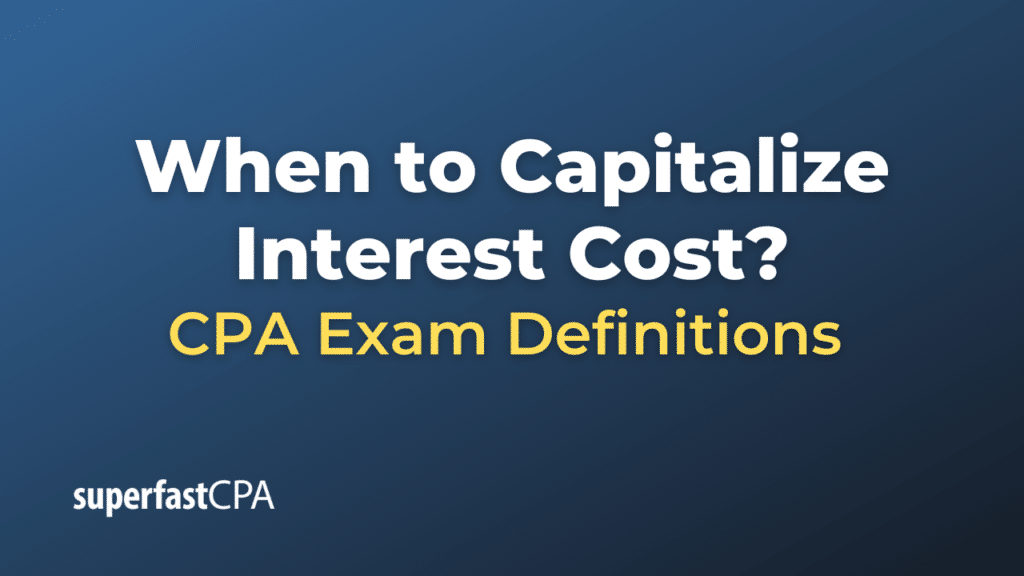When to Capitalize Interest Cost
In accounting, interest costs are typically capitalized when they are directly attributable to the acquisition, construction, or production of a qualifying asset. A qualifying asset is an asset that necessarily takes a substantial period of time to get ready for its intended use or sale. This could include assets like buildings, manufacturing plants, power generation facilities, and even certain kinds of software and intangible assets.
The rationale behind capitalizing interest costs is to better match the cost of the asset with the benefits it will produce over time, thereby adhering to the matching principle in accounting. By capitalizing the interest, a business spreads the cost of borrowing over the useful life of the asset, rather than recognizing it immediately as an expense.
Here are some general guidelines to follow:
- Identify Qualifying Assets: The first step is to identify the assets that qualify for interest capitalization. These are typically long-term assets that require a significant period to be ready for use.
- Interest Rate: Determine the appropriate interest rate to use. If the borrowing is specifically for the asset, then use that rate; otherwise, a weighted-average rate of all borrowings may be used.
- Expenditures: Keep track of the expenditures made towards the qualifying asset during the period it is being prepared for use.
- Capitalization Period: Identify the period during which expenditures are made and activities are undertaken to prepare the asset for its intended use, and during which interest cost is incurred. Interest should be capitalized only during this period.
- Calculations: Multiply the average accumulated expenditures for the asset by the capitalization rate to determine the amount of interest to be capitalized.
- Cease Capitalization: Stop capitalizing when the asset is substantially ready for use or sale, even if not yet placed in service or sold.
- Amortization: Once the asset is in use, the capitalized interest becomes part of the depreciable cost base of the asset and is expensed over the asset’s useful life through depreciation.
- Disclosure: Properly disclose the amount of interest capitalized in the financial statements or in the notes accompanying them, as required by accounting standards.
- Review Local Guidelines: Accounting standards can vary by country, so be sure to consult the specific standards that apply to your jurisdiction.
Note that not all businesses or all types of assets will meet the criteria for interest capitalization. Always consult with an accounting professional for advice tailored to your specific situation.
Example of When to Capitalize Interest Cost
Let’s consider a simple example to illustrate the concept of interest capitalization:
Imagine a company is constructing a new manufacturing plant. The project is expected to take two years to complete, and the total estimated cost is $2,000,000. The company finances this with a loan at an annual interest rate of 5%.
For simplicity, let’s assume that the company borrows the entire amount at the beginning of the project.
Steps:
- Identify Qualifying Asset: In this case, the manufacturing plant is a qualifying asset because it takes a substantial period of time to get ready for its intended use.
- Interest Rate: The interest rate on the specific loan for this asset is 5%.
- Expenditures: The total expenditure for the asset is $2,000,000.
- Capitalization Period: The plant takes two years to build, so interest will be capitalized during this period.
- Calculation:
- Interest for Year 1: 5% of $2,000,000 = $100,000
- Interest for Year 2: 5% of $2,000,000 = $100,000
- Total interest to be capitalized: $100,000 (Year 1) + $100,000 (Year 2) = $200,000
- Cease Capitalization: After two years, the plant is substantially ready for its intended use. At this point, interest capitalization stops.
- Amortization: The total cost of the asset, including capitalized interest, is $2,200,000 ($2,000,000 original cost + $200,000 capitalized interest). This amount will be depreciated over the useful life of the manufacturing plant.
- Disclosure: In the company’s financial statements, it would disclose that $200,000 of interest was capitalized during the construction of the plant.
- Local Guidelines: This example is a simplification. The company would also need to ensure it follows all relevant accounting standards and regulations.
By capitalizing the interest costs, the company is spreading the total cost of the manufacturing plant over its useful life, aligning the cost of the asset with the benefits it will provide over time.













